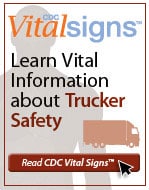Injury and Safety – Long-Haul Truck Drivers

Injury and Safety
On average, a long-haul trucker works 60 hours per week and drives more than 107,000 miles per year. [1] They are at risk of drowsy and distracted driving, and the consequences can be fatal. In 2012, 697 truck drivers, or their passengers, were killed in crashes.[2]
Drivers can prevent accidents and injuries:
- buckle up on every trip
- get enough sleep
- stay focused on the road
Truck crashes are preventable if drivers, employers, and others on the road work together to use safe tactics and follow safety laws.
What safety issues did we find?
Buckling up on every trip can prevent injuries and deaths in the event of roadway crashes.
We found 14% of the drivers said they sometimes or never wear a seatbelt.
Having unrealistic deadlines can increase the likelihood of unsafe actions, such as speeding, violating driving-hour regulations, and driving despite fatigue, bad weather, or heavy traffic.
We found 73% of the drivers perceived their delivery deadlines as unrealistically tight.
We found 24% of the drivers said they “often” continued to drive despite fatigue, bad weather, or heavy traffic; 47% of drivers said they continued to drive in these conditions “sometimes”.
We found 68% of company drivers who had a non-crash injury(s) involving days away from work did not report the injury(s) to their employer.
We found 35% of the drivers reported at least one crash in their career.
We found 38% of the drivers said they received inadequate training at the beginning of their careers.
What can the trucking community do to promote safety?
- Ensure that drivers’ schedules are not so tight that they might violate hours-of-service rules to make on-time deliveries.
- Be sure drivers are aware of and adhere to cargo securement and weight limits, safe driving techniques, and ways to avoid drowsy or distracted driving.
- Ensure that entry-level truck driver training meets current needs.
- Ensure the highest level of leadership commits to driver safety programs.
- Establish and enforce, such as requiring everyone in the truck to buckle up.
- Promote seat belt use in training and safety meetings.
To learn more, please check out CDC’s Vital Signs: Trucker safety.
Related Study Publications
For more details on the study and results, please see the journal articles, or contact us as eidinfo@cdc.gov
References
- Sieber WK, Robinson CF, Birdsey J, Chen GX, Hitchcock EM, Lincoln JE, Nakata A, Sweeney MH [2014]. Obesity and other risk factors: the national survey of U.S. long-haul truck driver health and injury. Am J Ind Med 57:615-626.
- CDC [2015]. Trucker safety. CDC Vital Signs, March 2015. Atlanta, GA: U.S. Department of Health and Human Services, Centers for Disease Control and Prevention,

